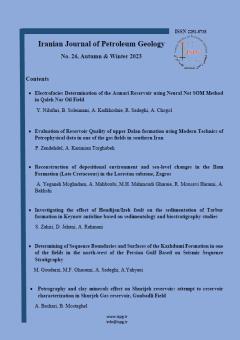Reconstruction of depositional environment and sea-level changes in the Ilam Formation in the Lorestan subzone
Subject Areas : Sedimentology and analysis of sedimentary basinsAtefeh Yeganeh Moghadam 1 , Asadollah Mahboubi 2 , Mohammad Hosein Mahmoudi Gharaei 3 , Reza Moussavi-Harami 4 , Arsalan Bakhshi 5
1 - Department of Geology, Faculty of Science, Ferdowsi University of Mashhad, Mashhad, Iran
2 - دانشگاه فردوسی مشهد
3 - Department of Geology, Faculty of Science, Ferdowsi University of Mashhad, Mashhad, Iran,
4 - Department of Geology, Faculty of Science, Ferdowsi University of Mashhad, Mashhad, Iran
5 - National Iranian Oil Company, Tehran, Iran
Keywords: Ilam Formation, Zagros, carbonate platform, Upper Cretaceous, sequence stratigraphy,
Abstract :
The Ilam Formation is considered one of the most important reservoir formations in Iran due to its significant extent in the Upper Cretaceous of the Zagros Zone. The changes in facies, lithology, and depositional environment from shallow to deep marine settings have played a considerable role in enhancing the reservoir characteristics of this formation. This study focuses on the Ilam Formation in the well No.1 of Babaghir oilfield and two surface sections of Tange-Hamam and Azgeleh in the Lorestan subzone for reconstruction of the depositional environment and sea-level changes during the Upper Cretaceous. In the study area, the Ilam Formation primarily composed of limestone and shaly limestone. The microfacies identified include mudstone to mudstone with planktonic foraminifera, wackestone with planktonic foraminifera, wackestone-packstone with planktonic foraminifera and oligosteginids, and wackestone-packstone with planktonic foraminifera and skeletal fragments. Based on textural characteristics and evidence of gravity currents, it is believed that the Ilam Formation in the study area was formed in a carbonate shelf. Sequence stratigraphy analysis in the study area has revealed a third-order depositional sequence with transgressive-regressive system tracts. The evolution of carbonate platform of the Ilam Formation has been significantly influenced by global sea level fluctuations, dominant warm climate, and palaeogeographic conditions during the Upper Cretaceous.
